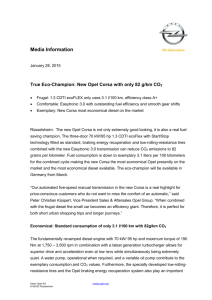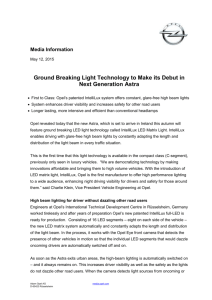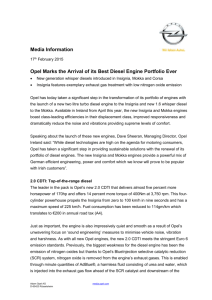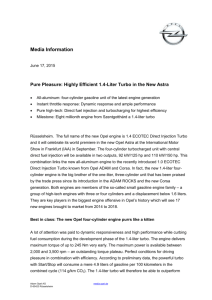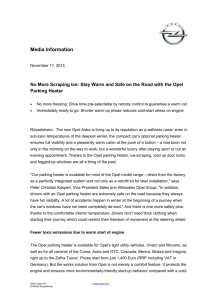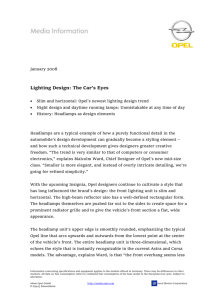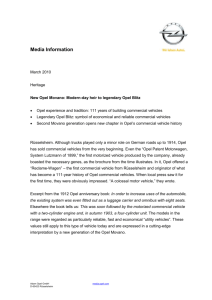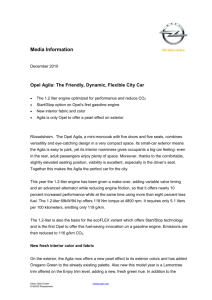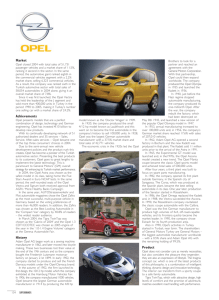EN_7_Flextreme_History
advertisement
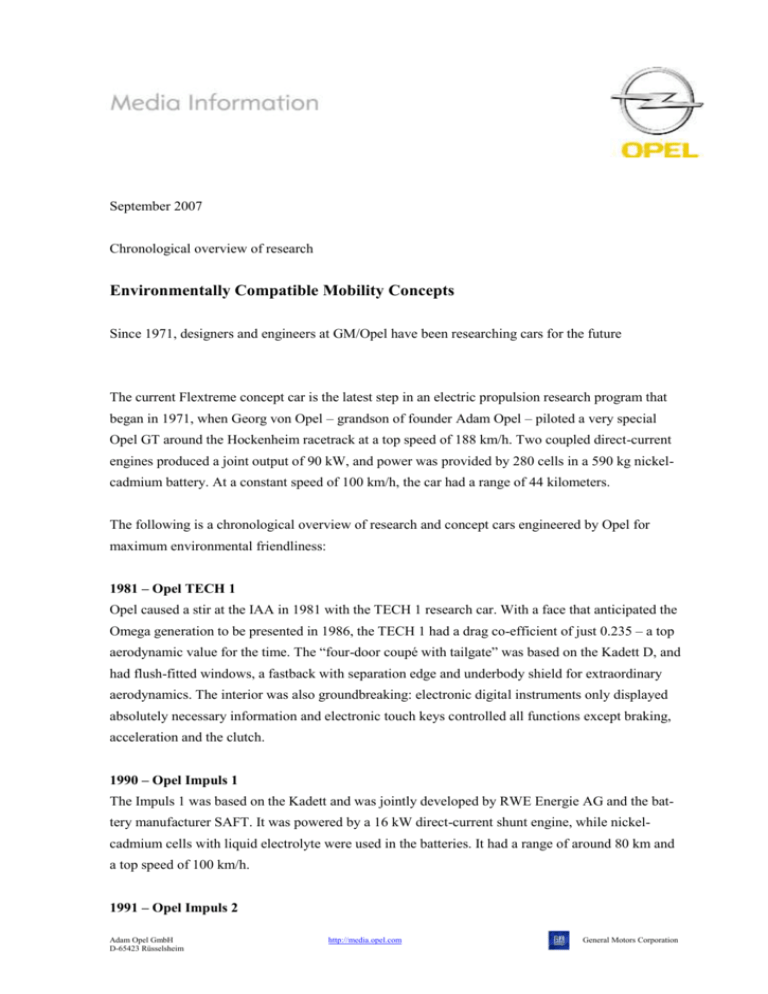
September 2007 Chronological overview of research Environmentally Compatible Mobility Concepts Since 1971, designers and engineers at GM/Opel have been researching cars for the future The current Flextreme concept car is the latest step in an electric propulsion research program that began in 1971, when Georg von Opel – grandson of founder Adam Opel – piloted a very special Opel GT around the Hockenheim racetrack at a top speed of 188 km/h. Two coupled direct-current engines produced a joint output of 90 kW, and power was provided by 280 cells in a 590 kg nickelcadmium battery. At a constant speed of 100 km/h, the car had a range of 44 kilometers. The following is a chronological overview of research and concept cars engineered by Opel for maximum environmental friendliness: 1981 – Opel TECH 1 Opel caused a stir at the IAA in 1981 with the TECH 1 research car. With a face that anticipated the Omega generation to be presented in 1986, the TECH 1 had a drag co-efficient of just 0.235 – a top aerodynamic value for the time. The “four-door coupé with tailgate” was based on the Kadett D, and had flush-fitted windows, a fastback with separation edge and underbody shield for extraordinary aerodynamics. The interior was also groundbreaking: electronic digital instruments only displayed absolutely necessary information and electronic touch keys controlled all functions except braking, acceleration and the clutch. 1990 – Opel Impuls 1 The Impuls 1 was based on the Kadett and was jointly developed by RWE Energie AG and the battery manufacturer SAFT. It was powered by a 16 kW direct-current shunt engine, while nickelcadmium cells with liquid electrolyte were used in the batteries. It had a range of around 80 km and a top speed of 100 km/h. 1991 – Opel Impuls 2 Adam Opel GmbH D-65423 Rüsselsheim http://media.opel.com General Motors Corporation -2- Opel Advanced Development engineers designed a pre-production electric vehicle for four passengers based on the Astra station wagon for the 1991 IAA. Called Impuls 2, the Opel prototype featured propulsion technology from the electric sports car Impact that General Motors presented in spring 1990. In total, 32 lead-acid batteries delivered power to two three-phase asynchronous motors with a joint output of 85 kW/115 hp. 1991 – Opel Eco 2 With a Euromix consumption of five liters per 100 km, the Opel Eco 2 required around 27 percent less fuel than a comparable production engine of that time. The research vehicle featured a 1.6-liter gasoline engine that generated 50 kW/68 hp and an automatic clutch with a Start/Stop function, which automatically shut off the warm engine at stops – for example at traffic lights. Special characteristics of the concept car included the engine modifications as well as improved aerodynamics and special tires with reduced rolling resistance. 1992 – Opel Twin Highlights of the much acclaimed Twin concept car included interchangeable drive units, with the engine, transmission, rear axle and energy accumulator housed inside. The vehicle thus ran on whichever drive assembly was most environmentally compatible and economical in any given situation. For instance, a three-cylinder gasoline engine (0.8 liter, 34 hp) was used for highway driving while an electric unit with two wheel-hub motors (each with 14 hp) came into play for city and short-distance driving. The drive train was located in the rear, allowing an unusual seating layout: instead of sitting front left, the driver had a central single-seat position, with three passenger seats in the back. 1993 – Opel Astra Impuls 3 The Impuls 3 was based on the Astra station wagon and was just as practical as the production vehicle with a combustion engine. It offered space for five passengers, had a big, versatile luggage compartment and a high payload. From 1993 to 1997, Opel entered ten Impuls 3 models in a large-scale electric car test on the island of Rügen, with the vehicles covering a total of more than 350,000 kilometers. Five electric Astras were fitted with nickel-cadmium batteries and the other five with sodium/nickel-chloride high-energy batteries. The three-phase asynchronous engine developed 45/42 kW. 1995 – Opel Corsa Eco 3 concept -3- The Opel Corsa Eco 3, the world’s first drivable “three-liter” car, made its debut at the 1995 IAA in Frankfurt. One year later, the prototype achieved an average consumption of 2.69 liters diesel per 100 km during the ECO Tour of Europe. Intelligent lightweight construction contributed to its record-setting fuel efficiency: hood, doors and fenders were made of composite materials reinforced with carbon fiber, and the chassis components were aluminum. 1995 – Opel Combo Plus In late 1995, Opel presented a pre-production proposal for an environmentally compatible city logistics concept car. Two sodium/nickel-chloride high-energy batteries operated in combination with a 45 kW three-phase asynchronous engine to provide noiseless propulsion in the Combo Plus. The special innovation in this electric vehicle concept: the batteries mounted under the car floor could be changed in ten minutes, providing a further 200 kilometers of operating range. 1996 – General Motors EV1 Strictly speaking, the EV1 was not a concept car, as 1,117 units of the electric coupé were produced, 800 of which were delivered to customers in California and Arizona under a leasing agreement. The EV1 was based on the “Impuls” concept car and propelled by a three-phase alternating current induction engine. Thanks to its light aluminum design and details like ultra-light magnesium wheels, extremely low air resistance of cd=0.19 and energy recuperation from braking, the EV1 had a respectable range of up to 240 km. Two different batteries were used, each with 26 accumulators. The first battery pack consisted of 12-volt lead-acid accumulators producing 18.7 kWh of energy, later 13.2-volt nickel-metal hydride accumulators with 26.4 kWh energy content were used. 1999 – Opel G90 concept First presented at the IAA in Frankfurt in 1999, the low-emission G90 Opel concept car weighed just 750 kg. The G90 name given to the spacious four-seater in the Astra category had special significance: the concept vehicle – powered by a 44 kW/60 hp three-cylinder gasoline engine with a load controlled intake-port shutoff – had a CO2 emission figure of just 90 g per kilometer. This corresponded to an MVEG standard consumption of 3.88 liters per 100 kilometers. This outstanding fuel efficiency was achieved by consistent lightweight design and an extremely low cd value for a vehicle of this size, 0.22. At the same time, the G90 – whose body lines provided a hint at future Opel vehicle design language – broke new ground in interior design. 2002 – Opel Eco Speedster Concept -4- The aerodynamic and low-weight Eco Speedster prototype with its spectacular fastback body impressively demonstrated the performance of the 1.3 CDTI ECOTEC engine. With an output of 82 kW/112 hp, the concept car reached a top speed of over 250 km/h during initial tests, yet consumed only 2.5 liters of diesel per 100 km (MVEG cycle). Based on the mid-engine Speedster sports car, the two-seat concept car displayed in Paris carried on the tradition of the 1972 world record-setting Opel GT. It had a carbon fiber body with considerably improved aerodynamics (Cd = 0.20) and weighed only around 660 kg. 2005 – Opel Astra Diesel Hybrid concept The Opel Astra Diesel Hybrid offered fuel consumption reductions of up to 25 percent with even more driving fun. The concept car was powered by a 92 kW/125 hp 1.7 CDTI engine with a maintenance-free particulate filter, as well as two electric motors with outputs of 30 and 40 kilowatts. Depending on the driving conditions, the electric motors delivered additional power for the diesel engine or propelled the Astra on electric power alone. A sophisticated engine control module determined the mode, which was then realized by the hybrid transmission. The electric motors’ boost function provided excellent driving performance: acceleration from zero to 100 km/h took less than eight seconds. And with an MVEG combined consumption of less than four liters, the concept car was very sparing with fuel. Contact: Karl Mauer +49-6142-7-72220 +49-171-3348210 Text and photos can be downloaded from the Internet at http://media.opel.com.
